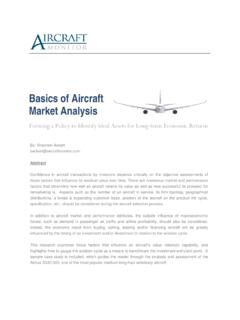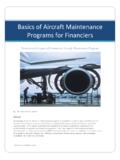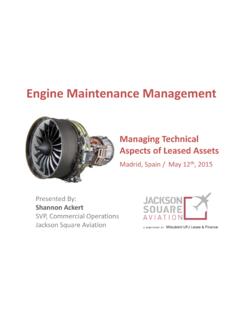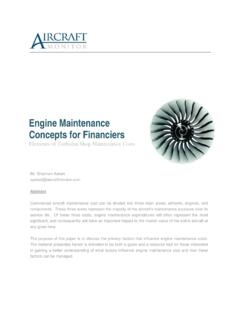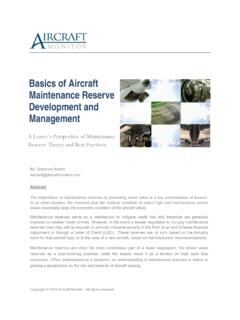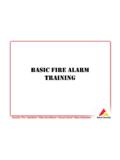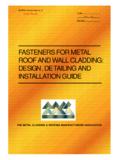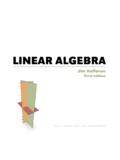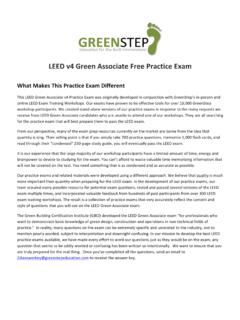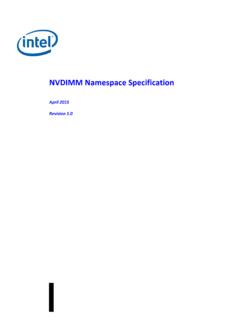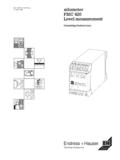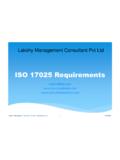Transcription of Aircraft Maintenance Handbook For Financiers
1 Aircraft Maintenance Handbook for FinanciersBy : Shannon Ackert1stEdition, 2018 Copyright 2018 Aircraft Monitor. All rights .. Principles .. Design Concepts .. Maintenance Concepts .. Reserves .. Influencing Maintenance Reserves .. Hour Agreements (FHAs) .. Manufacturer Approval (PMA) .. Engineering Representative (DER) Repairs ..Appendix A Typical Aircraft Maintenance Reserves ..References ..234334577102125131139143150 Table of ContentsAircraft Maintenance Handbook for Financiersprovides an introductory level description of theprinciples, general practices and economic characteristics associated with Aircraft Maintenance . Thehandbook is aimed largely for Financiers and students and, indeed, anyone interested in theunderlying concepts of Aircraft Handbook begins with an introduction into Aircraft Maintenance principles; highlighting thebuilding blocks of today s Maintenance programand analyzing those concepts that influencemaintenance status and valuation.
2 Information is assembled detailing the fundamentals of turbofandesign and Maintenance concepts; a prerequisite knowledge for all involved in Aircraft in depth analysis of Aircraft Maintenance reserves is covered, including identifying those factorsthat influence Maintenance costs and time on wing performance. For each Maintenance event,practical exercises in calculating Maintenance reserves is also of Flight Hour Agreements (FHAs), Part Manufacturer Approval (PMA), and DesignatedEngineering Representative (DER) repairs are introduced to guide the readers on how these issuesimpact commercial regarding any viewpoints or discrepancies is highly encouraged. To provide feedback,please e mail the author 1 Maintenance Cost Utility & Status4 The industry definition of Maintenance generally includes those tasks required to restore ormaintain an Aircraft s systems, components, and structures to an airworthy is required for three principal : To keep the Aircraft in a serviceable and reliable condition so as to Retention: To maintain the current and future value of the Aircraft by minimizing thephysical deterioration of the Aircraft throughout its Requirements.
3 The condition and the Maintenance of commercial Aircraft areregulated by the aviation authorities of the jurisdiction in which the Aircraft is requirements establish standards for repair, periodic overhauls, and alteration byrequiring that the owner or operator establish an airworthiness Maintenance and inspectionprogram to be carried out by certified individuals qualified to issue an Maintenance ProcessesAircraft Maintenance tasks & events can be categorized by one of the following time: A primary Maintenance process under which an item must be removed fromservice at or before ascheduledspecified time. Airframe checks and Landing gearoverhaul events are example of events that are expressed as hard time Condition (OC):A Maintenance process restricted to components in whichdetermination of continued airworthiness can be made by visual checks, measurements,tests, or other means without a tear down inspection or overhaul.
4 These health checks are to be performed within the time limitations prescribed by an operator s approvedmaintenance component s performance tolerances and deterioration limits are generally outlinedin the Aircraft s Maintenance Manuals. Additional criteria used in determining eligibility fora component s on condition status consist of the ability to inspect a unit for corrosion &structural integrity without Maintenance ProgramBefore certification of a new Aircraft , the Aircraft manufacturer the Type Certificate (TC)holder must prepare and submit for approval to the relevant airworthiness authorities theinitialminimum scheduled Maintenance requirements. These minimum scheduledrequirements are outlined in theMaintenance Review Board Report (MRBR) Figure local regulatory authority approval, the MRBR is used as a framework around whicheach air carrier develops its own individualmaintenance program.
5 Although maintenanceprograms may vary widely, theinitial requirementsfor an Aircraft will be the same for tasks detailed in the MRBR cannot be deleted nor can the task content be changedwithout approval of the MRB Chairman or appropriate national regulatory authority. However,individual task intervals may be escalated based on satisfactory substantiation by the operator,and review and approval by the local regulatory tasks detailed in the MRBR: Developed by an Industry Steering Committee Distributed by Aircraft Manufacturer Constitute Minimum Initial Requirements Cannot be deleted nor changedFigure 1. Maintenance Review Board Report (MRBR) Maintenance ProgramThe MRB Report outlines the initial minimum scheduled Maintenance /inspection requirementsto be used in the development of an approved continuous airworthiness illustrated inFigure 2,TheMaintenance Planning Document (MPD) contains all the MRBrequirements plus mandatory scheduled Maintenance requirements that may only be changedwith the permission of the applicable airworthiness authority.
6 These supplemental inspectiontasks are detailed in the Aircraft sCertification Maintenance Requirement (CMR)andAirworthiness Limitation (AWL) MPD document providesmaintenance planning informationnecessary for operators to develop acustomized Maintenance document lists all recommendedscheduled Maintenance tasks forevery Aircraft The MPD Maintenance tasks, and the rectification of any deficiencies resulting from performance of such tasks, formsthe basis for the qualifying scope of work that is used to quantify airframe Maintenance 2. Maintenance Planning Document (MPD) Maintenance Program ACertification Maintenance Requirement (CMR)is a required periodic task, establishedduring the design certification of the airplane as an operating limitation of the typecertificate. CMRs usually result from a formal, numerical analysis conducted to showcompliance with catastrophic and hazardous failure CMR is intended to detect safety significant latent failures that would, in combinationwith one or more other specific failures or events, result in a hazardous or catastrophicfailure condition.
7 Example of a CMR task is performing a detail visual inspection of theelevator tab rods and tab mechanism. Airworthiness Limitations (AL)are a regulatory approved means of introducing certaininspections, or Maintenance practices, to prevent problems with certain replacement times, inspection intervals and related inspection procedures forstructural safe life parts are included in the AL document, and are required by theregulatory authorities as part of the Instructions for Continued Airworthiness. Example ofan AL task is performing a detailed inspection of the fuel tank wire bundles to preventpotential wire chafing and arcing to the fuel Maintenance ProgramMPD Task intervalsare specified in terms ofusage parameterssuch as flight hours, cycles, andcalendar time. The MPD tasks generally define the following: Task description and intervals at which each component and major assembly should beeither inspected, checked, cleaned, lubricated, replenished, adjusted and tested.
8 Intervals of specific structural inspections or sampling program; Intervals at which life limited / time controlled parts should be replaced / overhauled;Many MPD tasks have fixed,initial(or threshold) inspection intervals andrepeatinspectionintervals seeFigure 3. Often the repeat interval is the same as the initial interval, howeverthere are numerous tasks having repeat intervals that are shorter than the initial 3. Example Maintenance Planning Document (MPD) Task Intervals Maintenance ProgramMostScheduled MPD tasksare assigned into threeprogram groupingsconsisting of: 1.)Systems & Powerplant, 2.) Zonal Inspections, and 3.) Structural & Powerplant Programinclude all scheduled on wing functional andoperational Maintenance tasks related to the Aircraft systems, Auxiliary Power Unit(APU), engine, and task categoriesare detailed below, andFigure 4illustrates an example of a system related 4.
9 Example Systems TasksLUB = LUBRICATION Consumable replenishment by = SERVICING Consumable replenishment by = OPERATIONAL CHECK A failure finding task to determine if an item is fulfilling its intended purposes. VCK = VISUAL CHECK A visual failure finding task through observation to determine if an item is fulfilling its intended purpose. GVI = INSPECTION GENERAL VISUAL A visual examination that will detect obvious unsatisfactory conditionsFNC = FUNCTIONAL CHECK A quantitative check to determine if one or more functions of an item performs within specified = RESTORATION Reworking, replacement of parts or cleaning necessary to return an item to a specific = DISCARD The removal from service of an item at a specified life Maintenance Inspection Programpackages primarily General Visual (GV) inspection tasksinto one or more zonal inspections.
10 These inspections check for the general conditionand security of attachment of the accessible components, systems and structures itemscontained in defined zones. This includes checks for deterioration such as chafing oftubing, loose duct supports, wiring damage, cable and pulley wear, brackets, fluid leaks,electrical bonding, general condition of fasteners, inadequate drainage, etc., and generalcorrosion. The scope and intent of what is to be inspectedis based on what is visiblewithin the zone with the specified access 5illustrates an example of a zonalinspection 5. Example Zonal Inspection Maintenance Inspection Programis designed to provide timely detection and repair ofstructural damage which may occur in the fleet during commercial operations. Detectionof corrosion, stress corrosion, minor accidental damage and fatigue cracking by visualand/or Non Destructive Test (NDT) procedures is are three levels of inspections performed.
